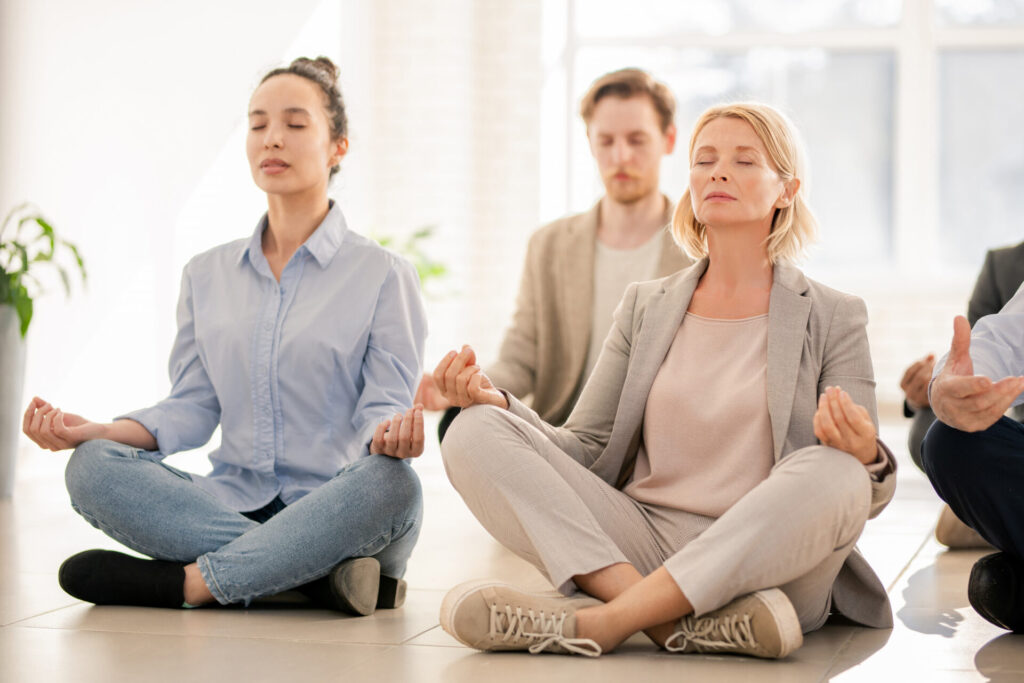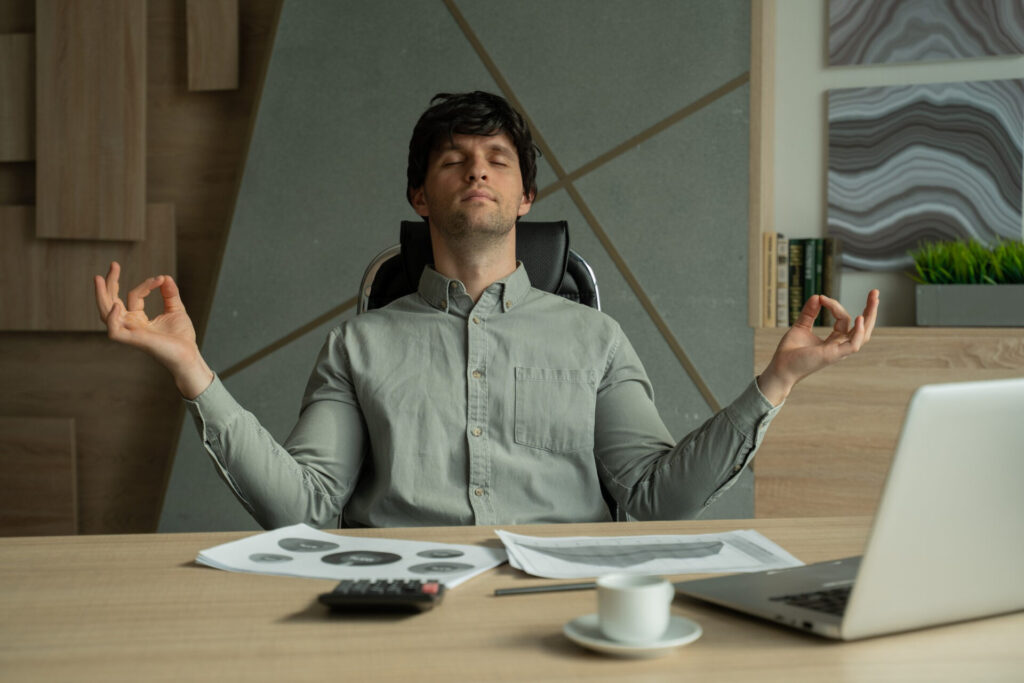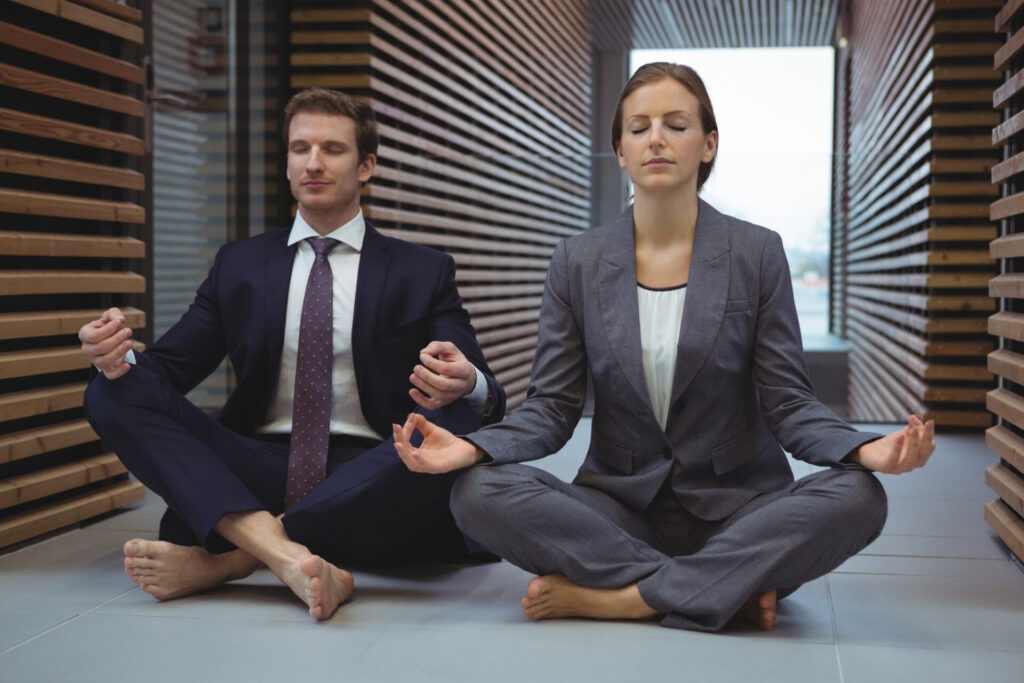Why Meditation Belongs in Your Busy Life
You rush from one task to another, juggling responsibilities, responding to emails, switching between meetings, and still trying to keep your personal life in balance. The modern schedule leaves little room for pause—yet that’s exactly why you need one. Meditation isn’t a luxury anymore; it’s a tool for survival in the chaos.
The myth? You need 30 minutes and total silence.
The reality? You need 3 minutes and the willingness to breathe.
“You should sit in meditation for twenty minutes a day. Unless you’re too busy—then you should sit for an hour.”
Zen proverb
Let’s be clear: this article is not about adding one more thing to your to-do list. It’s about reclaiming your mind during the day—without rearranging your schedule.
✔️ What You’ll Get from This Guide
This is a practical manual for meditation for busy schedules, built for professionals, parents, creators, and anyone short on time but rich in stress. Whether you’re looking for a 5-minute mindfulness routine, techniques for mental resets between meetings, or short daily meditation ideas to stay sharp, you’ll find it here.
You’ll learn:
🧘 How micro-meditations rewire your brain for clarity
📲 Which tools and breathing methods work best for busy people
📅 How to build a routine that fits, even if your calendar’s packed
This is not just theory—it’s a guide to real-life implementation. If you’ve ever said, “I don’t have time to meditate,” this article is written for you.
Let’s dive in by understanding why busy people need meditation more than anyone else.

Why Busy People Need Meditation
The Impact of Stress on Productivity
High workloads, tight deadlines, and endless responsibilities create chronic stress, which negatively affects productivity and mental well-being. Research from the American Psychological Association (APA) confirms that prolonged stress leads to:
✔️ Cognitive overload – Reduced ability to concentrate and make decisions
✔️ Emotional exhaustion – Increased irritability and burnout risk
✔️ Physical health decline – Higher chances of hypertension, heart disease, and weakened immune function
Meditation helps counteract these effects by activating the parasympathetic nervous system, which calms the body and mind. Even brief sessions improve focus and emotional regulation, allowing individuals to work more efficiently.
Common Misconceptions About Meditation
Many people avoid meditation due to myths that make it seem impractical for a busy lifestyle. Let’s debunk a few:
❌ “I need at least 30 minutes to meditate effectively.”
✔️ Reality: Studies show that even 5-minute meditation sessions can reduce stress and enhance focus.
❌ “Meditation requires a quiet place and complete stillness.”
✔️ Reality: Mindfulness can be practiced anywhere—while commuting, walking, or even in between meetings.
❌ “I need to clear my mind completely.”
✔️ Reality: Meditation isn’t about emptying your mind but about observing thoughts without judgment.
Benefits of Meditation for Busy Professionals
Research-backed advantages of meditation include:
📌 Enhanced focus – A study from Harvard University found that meditation increases gray matter in brain regions responsible for learning and memory.
📌 Reduced stress – A 2013 study in JAMA Internal Medicine found that mindfulness meditation significantly lowers anxiety and stress levels.
📌 Better decision-making – Neuroscientists at UCLA discovered that regular meditation strengthens the prefrontal cortex, the part of the brain responsible for rational thinking and decision-making.
With these benefits in mind, the next step is understanding the science behind how short meditation sessions impact the brain.

The Science Behind Quick Meditation
How Short Meditation Impacts the Brain
Many people believe that meditation requires long sessions to be effective, but neuroscience proves otherwise. Even brief meditation sessions can induce measurable changes in the brain.
🔬 Neuroplasticity: Studies show that meditation strengthens neural pathways, particularly in the prefrontal cortex, which governs decision-making, focus, and emotional regulation. Even five-minute sessions can activate these benefits over time.
🧠 Stress Reduction: The amygdala, responsible for processing fear and stress, becomes less reactive with regular mindfulness practice. This leads to a lower baseline level of stress, making you more resilient under pressure.
🔄 Cognitive Efficiency: Meditation enhances the brain’s default mode network (DMN), which is linked to mind-wandering. Short mindfulness exercises improve the ability to return focus to the task at hand, reducing mental fatigue.
The Role of Mindfulness in Stress Management
Meditation isn’t just about relaxation—it actively improves the body’s response to stress. The sympathetic nervous system (responsible for the fight-or-flight response) dominates during high-stress situations, leading to elevated cortisol levels, increased heart rate, and mental overwhelm.
Mindfulness meditation counteracts this by engaging the parasympathetic nervous system, promoting:
✔️ Lower blood pressure
✔️ Slower heart rate
✔️ A calmer, more balanced state of mind
A 2018 study published in Psychosomatic Medicine found that even short meditation breaks throughout the day reduce physiological markers of stress.
Research-Backed Benefits of Brief Meditation Sessions
Scientific studies confirm that meditation doesn’t have to be long to be effective. Here are some key findings:
📌 Better Focus: A study by the University of California, Santa Barbara, found that students who practiced 10-minute meditation sessions improved their working memory and attention span.
📌 Reduced Anxiety: Research from Johns Hopkins University concluded that mindfulness meditation can be as effective as medication in reducing symptoms of anxiety disorders.
📌 Improved Emotional Regulation: A study published in Cognitive, Affective, & Behavioral Neuroscience showed that individuals who meditated for just five minutes before a stressful task had better emotional control than those who didn’t.
These findings reinforce that meditation doesn’t require long hours—it simply needs consistency. The next challenge is finding time for meditation in a busy schedule. Let’s explore practical ways to integrate it seamlessly into daily life.

Finding Time for Meditation in a Busy Schedule
One of the biggest misconceptions about meditation is that it requires setting aside large chunks of time. In reality, mindfulness can be woven into everyday activities without disrupting your routine. Here’s how you can make meditation a natural part of your day.
Time-Blocking for Mindfulness
Time-blocking is a proven productivity method that helps busy individuals structure their day efficiently. The same technique can be applied to meditation. Instead of thinking of mindfulness as an additional task, integrate it into your schedule with small, intentional breaks.
✔️ Morning Start: A 5-minute meditation session right after waking up sets a calm tone for the day.
✔️ Pre-Work Focus Boost: A brief breathing exercise before diving into emails or meetings enhances concentration.
✔️ Midday Reset: A short body scan meditation during lunch can recharge your mental energy.
✔️ Evening Wind-Down: Ending the day with a mindful reflection or gratitude meditation improves sleep quality.
Integrating Meditation Into Daily Activities
Meditation doesn’t always require sitting in silence. It can be incorporated into activities you already do:
🚌 During Your Commute: Instead of scrolling through your phone, try mindful breathing while commuting. Focus on your breath or observe your surroundings without judgment.
☕ Mindful Coffee Breaks: While drinking coffee or tea, pay attention to the aroma, taste, and warmth. Engaging the senses in this way reduces stress and enhances presence.
🚶 Walking Meditation: Whether heading to a meeting or taking a short walk, focus on the sensation of each step, your breath, and the rhythm of movement.
🖥️ Before a Meeting or Task: Take 60 seconds to center yourself before engaging in an important conversation or a complex task. A deep breath and moment of stillness improve mental clarity.
Replacing Unproductive Habits with Meditation
Many people claim they “don’t have time” for meditation, yet spend hours daily on social media, watching TV, or engaging in mindless distractions. A simple way to introduce meditation into a busy life is by replacing some of these activities with mindfulness:
⏳ Swap 5 minutes of social media scrolling for mindful breathing.
📺 Replace 10 minutes of TV with a guided meditation before bed.
📱 Instead of immediately checking your phone in the morning, start with a brief body scan meditation.
By making small, intentional shifts, meditation becomes a habit rather than an obligation. The next step is choosing the right techniques to maximize the impact of these brief moments of mindfulness.
References and Inspirational Resources
- Kabat-Zinn, Jon. Wherever You Go, There You Are: Mindfulness Meditation in Everyday Life. Hachette Books.
- Davidson, Richard J. & Begley, Sharon. The Emotional Life of Your Brain: How Its Unique Patterns Affect the Way You Think, Feel, and Live—and How You Can Change Them. Plume.
- Harvard Health Publishing – Mindfulness meditation may ease anxiety, mental stress.
- JAMA Internal Medicine – Meditation Programs for Psychological Stress and Well-being: A Systematic Review and Meta-analysis.
- American Psychological Association – Research on stress, productivity, and mindfulness at work.
- UC Santa Barbara – Mindfulness training improves working memory and GRE performance.
- Insight Timer – App-based resources used for examples of short, guided meditations.















